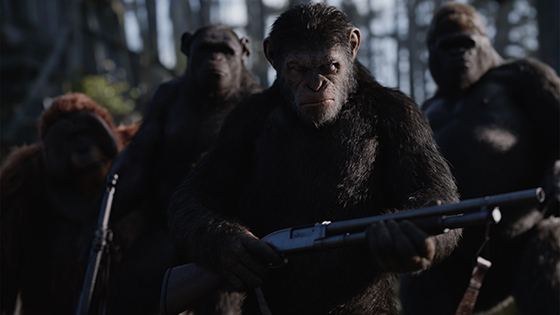War For The Planet Of The Apes

Twentieth Century Fox-TM & © 2017 Twentieth Century Fox Film Corporation. All Rights Reserved.

“With gorilla gone, will there be hope for man?”
In Ishmael, a novel by Daniel Quinn, a dialogue takes place between an ape and human who hash out the self-destructive history of intensive agriculture. The gorilla, named Ishmael, questions the uniquely human, mythological conceit that we are the apex of evolutionary biology.
This is the bookend that seems to drive Matt Reeves’ final chapter in the current PLANET OF THE APES trilogy. In the rebooted 2011 and 2014 installments of the franchise, humans are infected by a virus engineered originally as a drug treatment to combat Alzheimer’s. The primate test subjects of the program, however, flourished physically and mentally. With most of humanity eradicated by the Simian Flu, the third film opens in the heat of a territorial battle between Caesar (Andy Serkis), the de facto leader of the apes, and troops under the command of his unhinged opposite, the Colonel (Woody Harrelson).
Caesar and his closest advisers conclude that they must relocate to the desert on the other side of the Sierra Nevada mountain range. Harrelson’s Kurtz/Ahab archetype is obsessed with avenging the inevitable extinction of his species. In parallel, Caesar harbors anger at humans though not to the degree his rival, Koba, did in the two films prior. A large orangutan, Maurice (named likely for Maurice Evans, a.k.a. Dr. Zaius, in the 1968 original) reflects that they failed to understand just how much darkness Koba still carried within him. The third chapter reminds me of the triumph of Spike Lee’s DO THE RIGHT THING, of which Roger Ebert observed, “a movie about race in America that empathized with all the participants.” Replace “race” with “species” and there you have it.
Occasionally the imagery and the score rise above the limits of cinematographer Michael Seresin’s and composer Michael Giacchino’s repertoire, e.g. when Caesar leads a small group across a beach to a military fortification as the sun glistens off the water–the music, the imagery and the story forming a contrapuntal scene composition. However, the real feat of Reeves’ APES is in its character arcs. We’ve been trained to think Caesar is noble, Koba is flawed, and the Colonel is evil. The truth is that Caesar is flawed, Koba is a victim, and the Colonel is weak.
Reeves’ film muses over a self-evident truth about protagonists and antagonists: we all begin with intentions we believe to be right. If you know where PLANET OF THE APES (1968) begins, then you know where the Simian Flu takes the story. If you don’t: A mute child, whom the apes later name Nova (Amiah Miller), bridges the gap of understanding between the Colonel and Caesar. How she does so, I will not reveal.
In the middle chapter, Caesar’s prejudices blinded him to the betrayals by his own kind. We see both men haunted by their mistakes: Caesar has nightmares of Koba, darker than I would have imagined. We probably overlook the Colonel’s anguish, both because of the way he caricaturizes himself to create a fearsome image, and because of how recreational and self-medicating use of alcohol permeates our own culture. There all the time, we may not immediately recognize that the Colonel is, in fact, an alcoholic drowning in the sorrow of his own personal tragedy.
WAR FOR THE PLANET OF THE APES closes metaphorically where Quinn’s Ishmael begins, “With man gone, will there be hope for gorilla?”